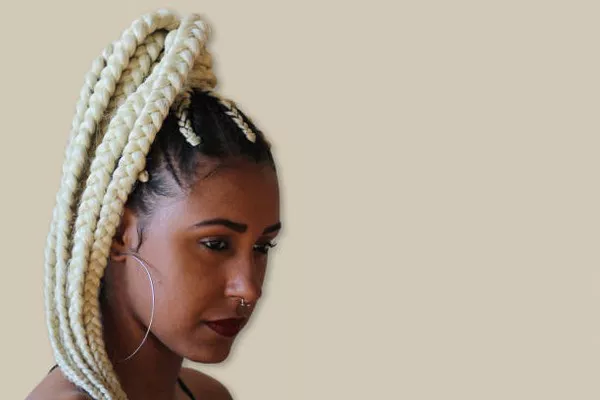Locs, often known as dreadlocks, have a rich history that spans thousands of years. In Ancient Egypt, for example, synthetic wigs made from a blend of palm fibers, wool, and human hair mimicked the appearance of locs and braids. Beyond mere fashion, locs are deeply symbolic, representing spirituality, freedom, and cultural identity. Award-winning hairstylist Charlotte Mensah, owner of Hair Lounge, notes that “Mami Wata,” a revered figure in West African folklore, embodies the essence of locs. With her long, twisted hair, she symbolizes abundance, fertility, and sexuality, as interpreted by the Igbo people of southeastern Nigeria.
On the Caribbean island of Jamaica, Rastafarians adhere to a philosophy known as “livity,” which emphasizes a harmonious lifestyle that includes wearing natural, minimally manipulated hairstyles. This philosophy complements a vegetarian diet and the wearing of colors associated with Pan-Africanism: red, green, gold, and black.
Embracing Natural Hair
Ama Safo, co-owner of Ama Hair Salon, discovered her passion for hair through various expressions of her natural coily hair, including locs. Upon moving to the UK from Ghana, she struggled to find her direction until a Jamaican friend encouraged her to share her hairstyling skills with others. Starting her journey by renting chairs in barbershops proved challenging, yet it fueled her ambition to open her own salon. Established in 2001, Ama Hair Salon has become known for its loc services, particularly barrel twists and double twists. Safo emphasizes the importance of prior consultations to recommend low-tension styles that minimize stress on the edges, a common cause of thinning and breakage, according to co-owner Silas Baiden. Their expertise has established the Tottenham salon as a key player in afro haircare, attracting clients like Ncuti Gatwa.
Understanding Starter Locs
At Hair Lounge, techniques such as starter twists and bohemian faux locs are popular choices. These styles are highly versatile, allowing for the addition of curly braiding hair extensions to enhance texture. For those with 4C hair measuring two to three inches, comb coils serve as an ideal starting point. “To create this look, a pencil-sized loc is formed by twisting small strands of hair around a twist comb,” explains Mensah. She cautions that the process can vary based on hair length and texture, noting that longer hair takes more time to loc. Additionally, softer hair may unravel upon contact with water.
Other starter loc options include mini twists and braids, as well as instant locs, which involve sectioning hair and tangling it into semi-mature locs with a steel crochet tool.
Maintaining Your Locs
The journey of growing locs requires discipline and care. “During our starter locs consultation, we inform clients about the importance of interlocking their hair regularly to maintain new growth,” Baiden says. He recommends interlocking every four to five weeks initially, then transitioning to every six to eight weeks as the locs mature. This process may require additional techniques, such as crochet needling, for those with looser hair textures. Importantly, new loc wearers should avoid washing their hair too soon after starting locs, as it may compromise their shape and integrity.
Should You Use Extensions?
Mensah believes that extensions can support healthy hair growth at the root. “If you’re looking for a specific aesthetic, extensions can help achieve that,” she explains. However, it’s crucial to consult with a professional beforehand to ensure the use of appropriate, high-quality human hair extensions that fit your loc journey.
Popular Loc Styles
Microlocs and Sisterlocks
Microlocs and sisterlocks, the smallest loc styles, take considerable time to install and require meticulous upkeep, making them the most expensive options. Their complexity is balanced by incredible versatility. The Sisterlocks system, created by Dr. JoAnne Cornwell in the 1990s, utilizes a special tool for locking hair.
Natural Bohemian Locs
Natural bohemian locs incorporate personal style into traditional locs. A notable example is Lisa Bonet, who adorns her wavy locks with elaborate braids, unique hats, and vibrant colors. Similarly, goddess faux locs combine natural hair with synthetic extensions to create a long, wavy, mermaid-like appearance.
Freeform and Semi-Freeform Locs
Often regarded as the least demanding loc style, freeform locs allow hair to grow naturally, resulting in a unique aesthetic. Many clients start these locs independently by forming twists and then allowing their hair to follow its natural course. Baiden notes that some may still use crocheting to direct the hair’s growth if needed.
To achieve this style at home, Mensah suggests sectioning washed hair according to desired loc size—smaller sections yield thinner locs, while larger ones produce thicker ones.
Faux Locs
Faux locs are designed to imitate mature locs without the long-term commitment. Natural hair is braided or twisted beneath synthetic hair, creating a fuller appearance. Mensah describes faux locs as an excellent way to experiment with the loc look, offering endless styling options, including curly ends for added texture.
Jumbo Twists
Jumbo twists are an excellent starting point for natural locs. In this method, hair is divided and twisted from root to tip. This style demands slightly less commitment than others, allowing for the possibility of combing out and styling the hair as an afro before the twists mature.
In conclusion, whether you’re looking to express your individuality or embrace your cultural heritage, locs offer a versatile and meaningful hairstyle option for those with afro-textured hair.
Related Topics:
12 Knotless Braids For The Beach
How To Easily Create Seamless Braids At Home
How To Make Braided Hairstyles Look Thicker


